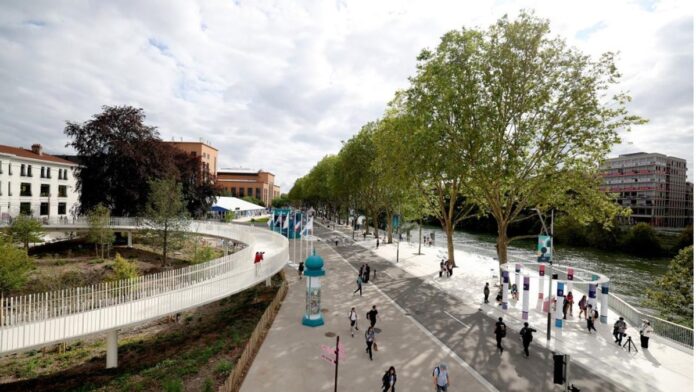
Picturesque: A general view of the plaza inside the Village with the Seine in the background.
| Photo Credit: Getty Images
From making its first appearance here as a novel concept in 1924, the Olympic Games Village has come a long way to be an environmentally friendly legacy project for Paris 2024.
If the first ever Games Village — a cluster of temporary wooden huts near the Colombes Stadium catered to the athletes with some basic facilities, including a post-office, a restaurant, a hairdresser, a newspaper kiosk, a laundry and a foreign exchange outlet — the latest one is promoted not only as a home away from home but also aims at benefitting the locals post the Games.
Built on a former industrial wasteland bordering the communes of Saint-Denis, Saint-Ouen-sur-Seine and L’île-Saint-Denis, the now-buzzing and heavily guarded Olympic Village will be transformed into a sustainable city district, with housing, offices and shops, where almost 12,000 people will live and work by 2025.
The Village, built on the banks of the Seine and consisting of 40 modern towers (including 2800 apartments) and plenty of plantation, has been designed keeping in mind Paris 2024’s target of lowering carbon emissions significantly and living up to environmental challenges even after two-and-a-half decades.
Solutions for low-carbon construction and a site adapted to the climatic conditions of 2050 include triple glazing, cooling floors, green spaces and geothermal energy, according to the Games website.
For now, it will accommodate more than 14,000 athletes and support staff during the Olympics and another 8000 during the Paralympics.
To achieve sustainability goals, modular partitions will be re-used and furniture will have a second life after the Games. Beds made of cardboards, like the Tokyo Olympics, and mattresses made of recycled fishing nets are some of the steps taken in this regard.
Running on 100 per cent renewable energy and designed without air-conditioners was a conscious decision taken to align with the Games’ go-green philosophy.
“The atmosphere in the Village is good, the weather is nice. Living and eating in the Village is very good,” said five-time Olympian Sharath Kamal.

